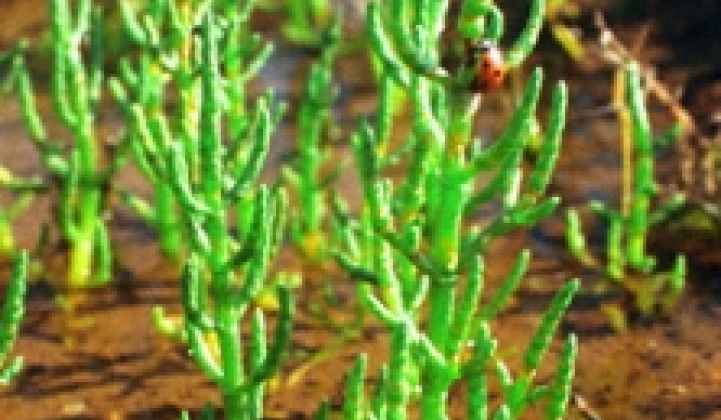Abu Dhabi - Take marginal land, fish waste and a plant that's not currently cultivated for human purposes and what do you get? Hopefully jet fuel.
The Masdar Institute of Science and Technology, Honeywell UOP, Boeing and Ethiad Airways announced a project on the eve of the World Future Energy Summit to study how to combine fish farms and biofuel crops in a manner that will also potentially reduce carbon dioxide as well as the amount of waste going into oceans.
The project essentially revolves around an oily plant called Salicornia (also known as pickleweed and sea asparagus) that grows in salty water in the region. Under the plan, fish farmers would create ponds and streams for raising shrimp and/or tilapia interspersed with Salicornia and mangrove, which also grows natively. The fish would be harvested for food. Their waste-which can run into the ocean and pollute it -- would be absorbed by the Salicornia and mangrove as fertilizer.
The Salicornia could then be harvested for oil, which could be converted into jet fuel or biodiesel. The seed meal left over after the plant gets squeezed, meanwhile, could be converted into fish food while the straw of the plant could get burned in a biomass reactor to produce electricity, according to Scott Kennedy, an associate professor at the Masdar Institute, a graduate school created here with MIT's help focused on alternative energy. It's a whole cycle of life thing.
"It is a much more commercial ready process" than some forms of algae cultivation, Kennedy said.
What does the mangrove do? It consumes some of the fish waste and sequesters carbon dioxide. Potentially, the mangrove could ultimately make the fuel carbon negative by helping the entire ecosystem capture more carbon dioxide that would get released when the fuel is burned, other speakers noted.
The project is just starting now, but in three to five years the sponsors hope to show that the interlinked system will be economically viable. The first stage will be a pilot farm, which will cover around two square kilometers.
Although Abu Dhabi has experienced an explosion of wealth from oil over the last five decades, the emirate (part of the United Arab Emirates) is investing heavily in alternative energy technologies and energy efficiency as the peak potential for its oil fields approaches. By 2020, it wants to get 7 percent of its energy from alternatives. World leaders have gathered here this week to discuss alternative energies at the conference and Abu Dhabi, naturally, will use the occasion to show off the progress of Masdar City, the industrial park/university/net zero energy residential complex under construction.
Despite the sometimes rocky history of ethanol and other alternative fuels, alt fuels will compose a huge market, added Jennifer Holmgren, the vice president and general manager of renewable energy and chemicals at Honeywell UOP.
"Energy demand will grow 2 percent a year. That means that over the next 40 years, the world will double its energy consumption," she said. "Future fuels must be drop-in replacements. They must use the same infrastructure."
Feedstocks for alternative fuels will also become regional with different nations growing the plants that best suit their environments. Salicornia is native to the Middle East and doesn't require fresh water, a big plus in a region that gets little rainfall.
So what are the challenges? Salicornia, which grows only about ten centimeters high, has never been harvested and grown for human consumption, noted Kennedy, so no one really knows the challenges of growing it in large amounts. The plant will also have to be optimized for increased oil yields. Commercial production of Salicornia will also require vast tracks of land-orders of magnitude larger than the pilot plant.
The different elements of the system need to be tweaked as well. How much fish waste can the plants absorb? How will crop harvesting impact fish farming?
"The challenge is a systems integration problem," said John Perkins, the provost for the Masdar Institute.



